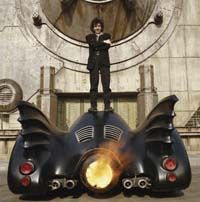Batman looks down from a Gotham rooftop into the dark alley below. We hear the sounds of the big city: cars whizzing by, sirens wailing in the distance, indistinguishable voices calling to each other from the street. The Joker and his henchmen enter the alley dragging a helpless Vicki Vale. We hear Vicki's muffled screams, the Joker's evil cackle and the scrape of Vicki's high heels across the pavement.
The movie score swells as Batman dives from the rooftop. We hear the metallic whir of his zip line and his leather cape snapping as it cuts through the air. Then comes the fight -- the punches, grunts, thumps and slams punctuated by blaring horns and sharp percussion from the soundtrack.
Advertisement
On the screen, this scene takes less than a minute. But behind the scenes, professional audio post production engineers worked hundreds of hours to make sure that every snippet of dialogue, every scrape of a shoe, every tiny detail of background noise, every sound effect and every second of the film score are perfectly blended to create a cohesive and powerful cinematic experience.
Audio post-production editors won't ever be famous (they don't even give them speech time at the Oscars), but the work they do is crucial to film and television productions. A screenwriter can come up with the funniest dialogue in the world, but who's laughing if the audience can't hear it? A digital animation team can design dazzling characters and expansive virtual worlds, but often it's the audio details -- the ruffle of the character's clothes, the wind through the digital leaves and the subtle hints of the musical score -- that make the world come alive.
The tools of audio post production can be as low tech as a fist and a sirloin steak (for the most realistic punches) or as high tech as a sprawling mixing console powered by the latest digital editing software.
What are the different roles and responsibilities of an audio post-production team? And how does digital technology help post production engineers do their work faster and better than ever? Read on to find out.
Advertisement


